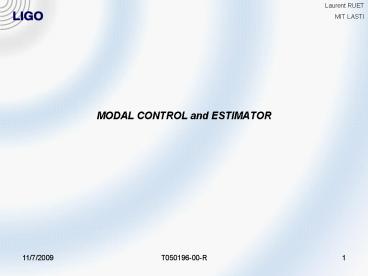MODAL CONTROL and ESTIMATOR - PowerPoint PPT Presentation
1 / 19
Title:
MODAL CONTROL and ESTIMATOR
Description:
Challenge : damp the resonances & reduce the sensor noise re-injection. 9/4/09. T050196-00-R ... Increase lower mode gain to keep a good damping ... – PowerPoint PPT presentation
Number of Views:68
Avg rating:3.0/5.0
Title: MODAL CONTROL and ESTIMATOR
1
MODAL CONTROL and ESTIMATOR
Laurent RUET MIT LASTI
2
TRIPLE PENDULUM
2 blades
4 blades
3
TRIPLE PENDULUM
- Vertical direction
4
INTRODUCTION
- Resonances to damp 0-10Hz
- 2 sources of noise
- Seismic noise
- Re-injected sensor noise
- Challenge damp the resonances reduce the
sensor noise re-injection
5
CLASSIC FEEDBACK CONTROL
- Motion of mass 1 is measured, filtered, and
re-injected as a force into mass 1. - Drawbacks of the classic filtering feedback
method - Time consuming and complex work to design filters
- Not flexible
- Performances are not very good
6
MODAL CONTROL MATHEMATICS
- Goal write the equations of dynamic in a new
basis so that the equations are uncoupled
Where ?2 are the eigenvalues and X are the
eigenvectors of inv(M)K.
In the new basis F formed by the vectors X
Matrix is now diagonal, equations are decoupled
7
MODAL CONTROL DECOMPOSITION
- We can design a control filter for each mode very
easily because the transfer function is very
simple - In practice, we use a parameterized filter (the
shape is the same for every filter but the
frequencies of poles/zero change depending on the
frequency of the mode) - Makes the filter design very simple do the
design once and use it for all modes
8
MODAL CONTROL CHOICE OF THE GAINS
- Simple filter parameterized with the mode
frequency
- Modal controller gains
- K180
- K23
- K30
9
MODAL CONTROL CONCLUSION
- How does modal control help ?
- Equations decoupled gt easy to choose gain and
filter for each mode - Lowest modes are easy to damp and filter gt good
damping - Highest modes can have lower gains gt reduce
noise transmission - But
- It needs as many measurement as DoF (needs to
know the full state), this is not possible with
the triple pendulum gt estimator
10
ESTIMATOR LAYOUT
Sensor noise v
Plant P
Estimator gain E
Ground excitation w
Model M
Modal controller C
11
ESTIMATOR INTRODUCTION
- The estimator reconstructs the full state of the
system - It compares the estimated output with the real
measurement to converge - It can also filter the noisy measurements
Closed loop
Equation of loop with no estimator
no control
12
ESTIMATOR FEEDBACK CONTROL
- Priority is stability
- Need to design a controller
- Filtered feedback
- MIMO (LQR, )
- Design of a filter and choice of the gain
- Choice of a very simple filter shape to optimize
stability and reduce HF noise
High gain at resonances
13
CHOICE OF ESTIMATOR FEEDBACK GAIN
- Stability
- Pole map of the closed loop
- The color represents the estimator gain
- System is unstable if the real part of the
polesgt0
- Damping/Noise
- X is sensor noise transmission at 20Hz (in dB)
- Y is settling time (in sec)
- Color is the estimator gain
- We choose E0.8
14
INFLUENCE OF EACH MODE ON SENSOR NOISE
TRANSMISSION
- Transfer function between sensor noise and bottom
mass motion, each modal controller turned on one
by one - Shows the influence of each modal controller on
the sensor noise injection - As expected, the lowest mode doesnt transmit a
lot of noise - All the noise is carried by the 2nd mode
- Tells you how to improve the controller
- Increase lower mode gain to keep a good damping
- Decrease highest mode gain to lower noise
injection
15
RESULTS
- Very good noise reduction with a simple filter
shape - More efficient than classic feedback for noise
filtering - Conclusion
- Easy to design
- Flexible
- Good performances
- Easy to improve
16
EXPERIMENTS
- Damping test on LASTI triple pendulum
- successful
- Noise test is difficult in LASTI
- Need to inject artificial sensor noise
- Relative sensors limit the experimentation
- gt optical cavity between 2 triple pendulums
Artificial sensor noise is injected to compensate
for big seismic noise Expected noise on the
bottom mass (X direction)
17
BETTER PERFORMANCES
- Improving the modal control filters is an easy
way to improve performances (example in Z here) - Work on MIMO estimator in progress, gain of few
dB expected
18
STABILITY WITH MODEL MISMATCH
- What happens if the model mismatch ?
- 1dof easy to simulate by adding /- 10 to the
resonance (see document) - Multi dof hard to quantify the mismatch, Monte-
Carlo on closed loop pole map - The parameters to know
- The resonances need to be well known (within 10)
- The Q doesnt need to be well known
5 mismatch
15 mismatch
10 mismatch
19
CONCLUSION
- The modal control has many advantages
- Easy to design
- Flexible
- Good performances in sensor noise re-injection
minimization - The estimator enables us to use modal control by
generating unknown states - The stability is easy to study and bad modeling
can be anticipated - Model could be adjusted to match the plant even
better (gradient minimization)































